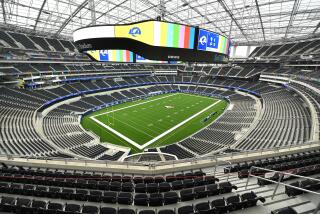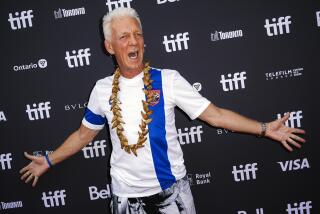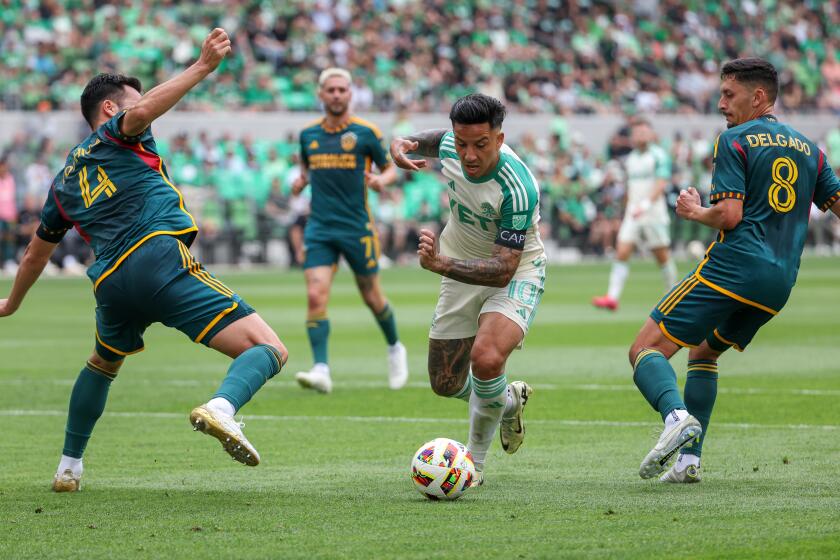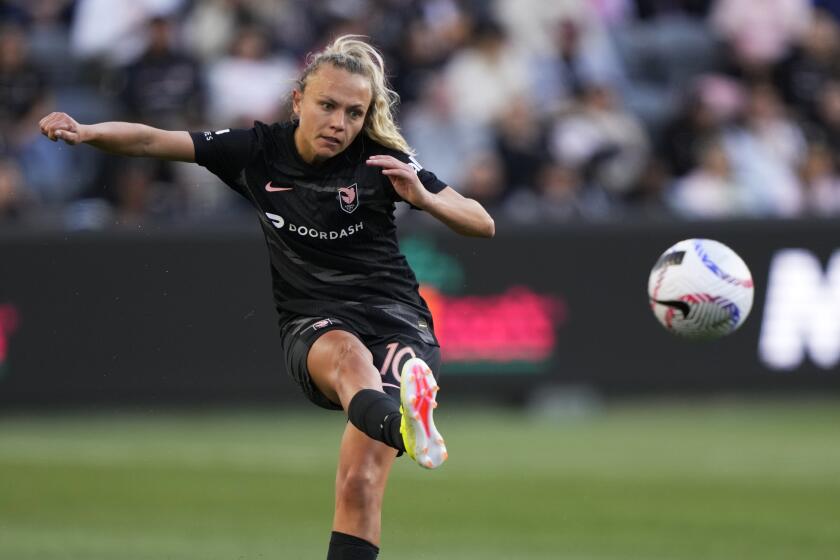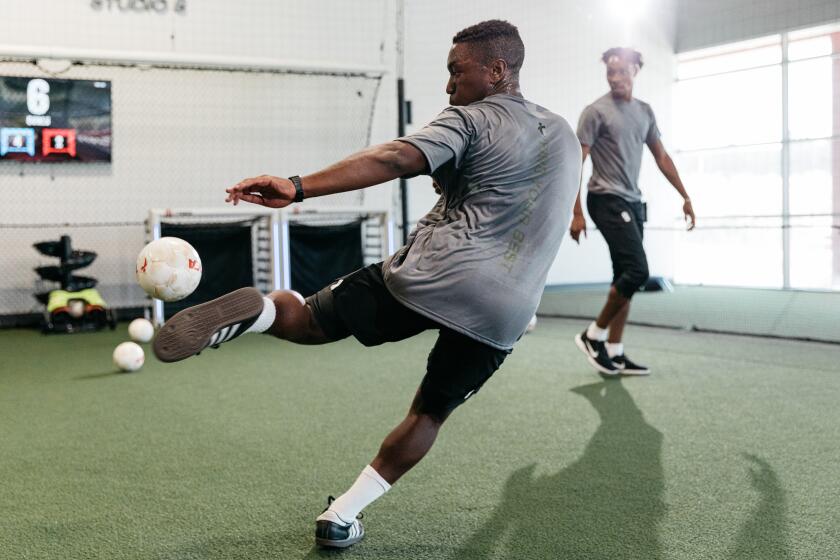Seattle soccer: A city drinks in Drew Carey’s love of the game
Hey bartender, have you seen Drew Carey?”
“Sure,” she says, pointing to a thicket of blue and green. Soccer lovers -- Seattle Sounders lovers to be precise -- crammed inside a beer-drenched bar.
His famous outline emerges, wide and square-jawed. The popular comedian and host of TV’s “The Price Is Right” stands by a bar stool, one of the gang -- the gang being the Emerald City Supporters, one of several fan groups that live and breathe the Sounders, the Major League Soccer team Carey partly owns that is playing its first season.
Game time is in two hours at nearby Qwest Field against the San Jose Earthquakes, and the fans are hyped.
Some thank him for bringing big-time soccer -- as big as it’s played in America at least -- to Seattle.
“Drew, Drew, never thought I’d see anything like this. You’re totally awesome, man!” says one. Others offer advice, from what to do about a struggling player to where the team’s crackerjack band should sit. “Drew, bud, we gotta talk. . . .” “Drew, ever think of this . . .?” “Drew, Drew, hey Mr. Carey . . .”
Most team owners would steer well clear of a place like this. But Carey, guided by his populist instincts and curiosity, wants to soak up the fans’ energy and hear their opinions.
Carey, schlumpy son of middle America, has become a soccer fiend and one of the game’s most ardent evangelists. He wants fans to share his goal of making soccer deeply popular in this country. He wants pro sports teams in the United States, particularly ones like the soulless L.A. Clippers, to replicate the Seattle Sounders’ tight, almost brotherly connection with fans.
Impossible, right? Team owners aren’t known for welcoming change. To think a trend will develop, says David Carter, executive director of the USC Sports Business Institute, “is simply wishful thinking.”
--
Soccer is hardly fertile ground for such a movement. This is Major League Soccer’s 14th season, yet ESPN this year scuttled its weekly “Primetime Thursday” showcase game because of meager ratings.
The Sounders, though, lead the MLS in attendance, having sold out the 29,000-seat Qwest Field for all 15 of their home games, right up to the final match in October that ends the 30-game season.
On this particular night in late April, as game time approaches, Carey ambles down the street toward the stadium, still surrounded by scores of fans, signing autographs, giving hugs. This is the start of the Sounders’ pregame parade. And Carey is at the heart of it.
With the wide-eyed, vaguely surprised look of a man who can’t get over his good fortune, he scans the crowd.
“Drew,” a woman says, pointing to a sea of fans lifting green-and-blue Sounders scarves to the sky. “Really beautiful!”
“Geez, I thought they’d be cool,” he says, noting that to build unity every season ticket holder was given a scarf, the way it’s done in Europe. “I mean, look at this. Wow.”
There is one more stop before the stadium -- Occidental Park, to listen to one of his great loves, the team’s marching band, 53 musicians strong. The rally, two blocks from the stadium, is a swelling sea of blue and green and part of the parade process.
A man approaches, his face painted in Sounders colors.
“Drew Carey, whoa,” he says, speaking loud enough to be heard over the trumpets and trombones. “Ever thought of painting half of your face blue and half of your face green?”
“Uh, no,” Carey deadpans. “If that’s your thing, man, that’s cool. Just keep coming to the games.”
It was serendipity that led Carey to became a soccer fiend. As a teen, he knew of the North American Soccer League, which included the first incarnation of the Seattle Sounders. He also recalls adults saying that no one would get hurt playing the game, predicting it would be the next big thing. It wasn’t. It did have a superstar, though: Brazil’s Pele.
When the NASL folded in 1984, Carey felt no loss.
“It was just that league that had Pele and then went down in a heap,” he says. “That’s all I ever thought . . . that soccer in America equals failure.”
By 2004, the comedian had his own fame thanks to his nine-year run on ABC with the sitcom “The Drew Carey Show.” He took some time off and returned to a childhood love: sports photography.
To practice, he chose soccer because the sport received so little attention. He could go to a U.S. national team game, sit on the sidelines with his camera and nobody would notice. He did well enough that a wire service hired him to shoot the 2006 World Cup. That changed his life.
“A complete revelation,” Carey says of World Cup play. “The sport all the parents tried to sell as not competitive . . . it was violent! Nothing but elbows and forearms. . . . Not competitive? Not tough? That’s like if someone were going to tell you, ‘Hey, you’re going to make your living going up for rebounds against LeBron James, but don’t worry, it’s not going to be very physical. It’s not going to hurt.’ I was hooked!”
He soon hungered to own an MLS franchise and arranged a meeting with Joe Roth, the former chairman of Disney Studios who was majority owner of the soon-to-be-launched Sounders.
It was August 2007, and Carey arrived at the introductory lunch with a heavily bandaged left wrist, the result of a prop going haywire that morning during taping of “The Price Is Right.” Roth wanted to take him to a hospital. Carey was focused on soccer.
“Joe, forget the wrist, I want to own part of the team,” Carey recalls saying. “But, oh, by the way, there are two conditions.”
Condition No. 1: A marching band. Carey was in his high school’s band and wanted to re-create that experience. Condition No. 2: Involve fans in a way no other team in America had. Carey trotted out prominent European examples: soccer juggernauts Barcelona and Real Madrid. Both hold elections to fill the singularly powerful role of team president. A pricey bond must be secured to seek the office, but anyone can run. Candidates campaign, often promising to sign the best players, and season ticket holders vote.
Roth remembers squirming, and Carey pressing for compromise. Reserve the right to hire the general manager, the comedian said. But every four years let the fans vote on whether the GM should stay. If there’s enough anger, fans can call for a no-confidence vote once a year.
“The fans can do your dirty work for you,” Carey argued.
Roth was sold, and Carey was in. The team has the band, of course, and all it takes to oust the GM is a majority vote by the 22,000 season ticket holders and fans who pay $125 to join a booster group.
Carey, 51, won’t divulge his ownership stake other than to say it’s large enough to get his voice heard but not large enough to have a final say. Most important to him, his vision is becoming real. Even better, it dovetails with Roth’s.
Roth figured Seattle -- wired, progressive, smarting from the loss of the NBA’s SuperSonics -- would embrace his team much as it did the original Sounders in the 1970s.
There are grander plans to create an academy here to house Sounders developmental squads for teens to help scoop up great athletes before they turn to basketball or football. Think LeBron James, striker.
“The future looks really bright. Right now, so does the present,” says Greg Roth, a Sounders supporter and no relation to the owner. Roth was elected by fans to a seat on the team’s council -- eight members so far -- that operates as a liaison between fans and owners.
This kind of fan involvement seems to be working.
Fueled by the Internet, Sounders booster clubs popped up not only in Seattle, but in L.A. and Denver. Fans chose the team’s name, pushed for more seating, created the pregame parade and lobbied to relocate the band to another part of Qwest Field after some complained about being too close to such a loud ensemble.
“We’ll help set the bar for what success is,” says Roth, the council member, noting that the team is adding 4,000 seats. “We feel we’re part of this grass-roots process.”
Still, despite Carey’s cheeky promise that the Sounders “will give fans pitchforks and torches” so they can remake the team if they’re not happy, at this early stage it’s not clear how much power fans will have -- or should have.
“Fans operate with their hearts and not their heads,” warns USC’s Carter. “The key will be how do the Sounders balance fan interaction and input with smart decision making? . . . They have to be very careful not to turn this into a circus.”
--
Greg Mockos, another Sounders council member and leader of the rambunctious Emerald City Supporters, understands such caution.
“There’s still a lot up in the air, but the way this team is doing its business is helping build an incredibly positive feeling here,” he says. “Drew is a huge part of that. . . . I e-mail back and forth with Drew. Who can say they do that with a dude who owns a sports team?”
At Occidental Park, the marching band, with its fondness for Red Hot Chili Peppers tunes, is going strong an hour before game time, and Carey is 10 feet in front of the band. The attention is nonstop. He poses for pictures, shakes hands.
“Cleveland rocks,” says one passing fan, repeating “The Drew Carey Show’s” catchphrase. “But Seattle rocks harder, don’t ya think?”
Carey nods. “Funny thing,” he says, “everyone here always thinks I’m the majority owner of this team, when I’m not. They think I brought them soccer. I didn’t. I just jumped on board with some of my ideas.”
It is time to begin moving to the stadium, the band in the lead. Carey walks with the fans, holding his Sounders scarf high, never at a loss for ideas. “How about we throw a huge, pregame fan barbecue this summer?” he blurts out, to no one in particular. “Right here, in the park; it’d be awesome.”
By the start of the game, Carey is in his box and Qwest Field is rocking with rhythmic chants: “Ooooh to be a Sounder! Oooo. Ooooh to be a Sounder!”
The match begins. Sometimes Carey is calm. Just as often he balls a fist, bites a nail, cusses like the Marine he once was. “I like the idea of this being a movement,” he says. “There’s no reason a team like the Clippers can’t do this, or a team like the Detroit Lions. What do teams like that have to lose?”
Control, someone suggests.
“That was the argument against democracy in the United States,” Carey replies, launching into a soliloquy in which he dismisses monarchies and applauds the masses.
“Let the fans vote for the GM? Don’t you vote for judges you’ve never heard of? I believe fans know way more about sports teams than they know about judges, and judge is a pretty important job. Look, the only way fans can ever have a say in the way a team is run right now, with most teams, is to stop coming. And that’s no way to run a business. We’re going to have lean years. When that happens, I want them to keep coming, and we do that by having them really involved.”
The soliloquy abruptly ends when he notices one of the Sounders streaking across the field, heading for the goal.
“Yeah, yeah, yeah!” he shouts, rising from his seat. “Oh . . . baby . . . yeah!”
Near the end of the first half, a Sounder plows in front of a high-kicked ball, sending it into the net for another goal.
“Chackalackalacka!” Carey shouts. “Yeah, that’s what I’m talkin’ about! Take that back to San Jose, fool!”
The game will end that way -- a 2-0 victory for Seattle. But right now Carey is pumped. When he’s not shouting, he’s beaming at the band and the fans, amazed. He is like this to the end, as green and blue confetti paints the air and the fans stand en masse, singing, chanting, yelling, unfurling Sounders scarves. It could have been London or Madrid. Maybe, one day, it will be New York or L.A.
“Look at this,” Carey says. “Look at what’s happening here. This is what American soccer can be.”
--
